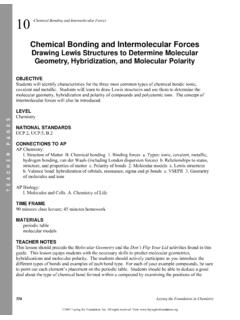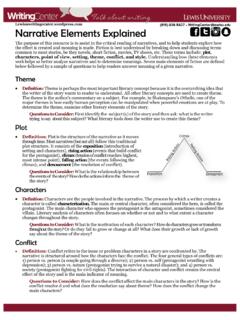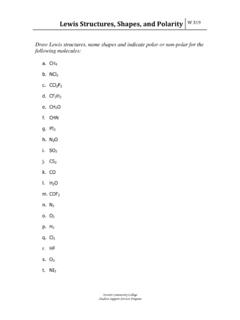Transcription of LEWIS STRUCTURES General Rules for Drawing Lewis Structures
1 LEWIS STRUCTURES General Rules for Drawing LEWIS STRUCTURES 1. All valence electrons of the atoms in LEWIS STRUCTURES must be shown. 2. Generally electrons are paired. Unpaired electrons are observed in odd electron molecules such as NO and NO2. 3. Generally each atom acquires eight electrons in its valence shell except hydrogen acquires only two electrons. 4. Multiple bonds (double and triple bonds) can be formed by C, N, O, P, and S. 5. Hydrogen atoms are terminal atoms. Hydrogen can accommodate a maximum of two electrons in its valence shell.
2 It can therefore only make one bond to one other atom. There are only very few exceptions to this rule (for example, diborane, B2H6, shown in Fig. , Pg. 879 of your text). 6. Central atoms are generally less electronegative then terminal atoms. For example, HCN is more stable than HNC because carbon is less electronegative then nitrogen. Carbon atoms are generally central atoms. Oxygen has a relatively high electronegativity and is observed to be a terminal atom in many molecules.
3 In alcohols, the O H group is attached to a carbon and eventhough hydrogen is less electronegative it must be a terminal atom. Also, in peroxides such as hydrogen peroxide, H2O2, the oxygen atoms are in the center (H O O H). 7. In Drawing LEWIS STRUCTURES for relatively small molecules and polyatomic ions, the STRUCTURES tend to be more stable when they are compact and symmetrical rather than extended chains of atoms. EXAMPLE: Write the LEWIS structure for CH2O where carbon is the central atom.
4 Step 1: Determine the total number of electrons available for bonding. Because only valence electrons are assumed to be involved in bonding we need to determine the total number of valence electrons. Total number of valence electrons: Electrons available CH2O C Group 4 4 2 H Group 1 2(1)
5 = 2 O Group 6 6 12 There are 12 electrons available for bonding. Step 2: Determine the number of electrons wanted by each atom. Electrons needed C needs 8 8 2 H each H needs 2 2(2) = 4 O needs 8 8 20 More electrons are needed then there are available.
6 Atoms therefore make bonds by sharing electrons. Two electrons are shared per bond. # of bonds = (# of electrons needed # of electrons available) / 2 = (20 12) / 2 = 4 bonds. Draw 4 bonds between the atoms. Carbon is indicated to be the central atom. This means all the other atoms are bound to carbon. To fill its valence shell, carbon can make 4 bonds, each of the hydrogen atoms can make one bond and oxygen can make two bonds. Remember that carbon, oxygen and nitrogen can form multiple bonds (double and triple bonds).
7 Step 3: Use remaining electrons to fill valence shell for each atom. All atoms need 8 electrons to fill their valence shell, except hydrogen needs only 2 electrons to fill its valence shell. For CH2O there are 4 bonds, and 2 electrons per bond. O | | H C H # electrons remaining = # electrons available # electrons used in bonds = 12 4(2) = 4 :O.
8 | | H C H Both the carbon and oxygen atoms have 8 electrons; each hydrogen atom has 2 electrons. Read Sections and in your text to understand resonance STRUCTURES and exceptions to the octet rule. For example, most atoms in the first and second row obey the octet rule except for boron and beryllium; these can be electron deficient in compounds.
9 Why can atoms in the third row expand their octet? For example, sulfur, the central atom in SF6, has 12 electrons around it, exceeding the octet rule. See pg. 298-299 of your text. ASSIGNING FORMAL CHARGE ON ATOMS IN COMPOUNDS Formal Charge = Number of valence electrons in the free atom (the Group Number) Electrons surrounding the atom in the compound (count each electron in the lone pair electrons and one electron for each bond). For example: In H2CO, the formal charge on the oxygen atom = 6 6 = 0, the formal charge on carbon = 4 4 = 0, and the formal charge on hydrogen = 1 1 = 0 In General , compounds with the lowest formal charges possible are favored.
10 For example, given the LEWIS STRUCTURES for CO2, based on the formal charges assigned decide which structure is favored. O C O O C O Formal charge: 0 0 0 1 0 +1 In the left hand structure of CO2 all the formal charges are zero and this structure is favored over the right hand structure. Note that the formal charges on the atoms must add up to zero for molecules that are neutral. For ionic compounds, the formal charges on the atoms must add up to the charge on the ion.








